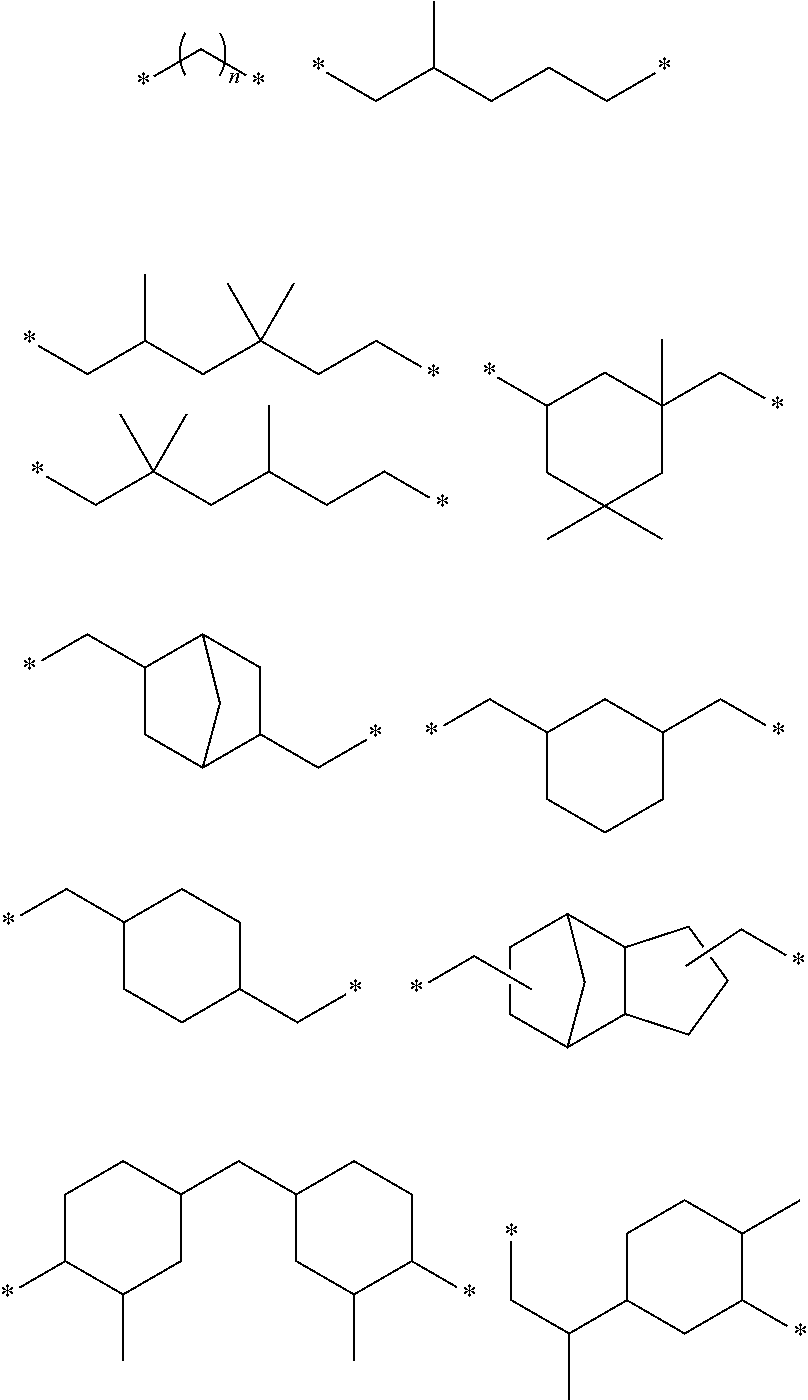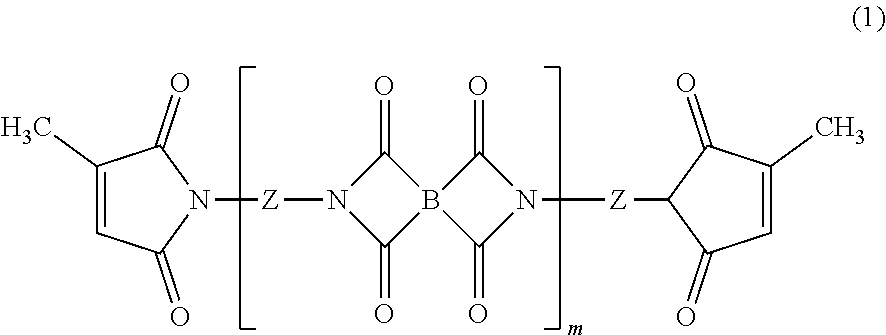Heat-curable citraconimide resin composition
a technology of citraconimide and citraconimide, which is applied in the direction of adhesive types, basic electric elements, semiconductor/solid-state device details, etc., can solve the problems that conventional curable resins may not be satisfactory, and achieve superior dielectric properties, low viscosity, and low relative permittivity
- Summary
- Abstract
- Description
- Claims
- Application Information
AI Technical Summary
Benefits of technology
Problems solved by technology
Method used
Image
Examples
working examples
[0066]The present invention is described in detail hereunder with reference to working and comparative examples; the present invention shall not be limited to the following working examples.
[0067]The components used in working and comparative examples are shown below. Here, in the description hereafter, a number average molecular weight (Mn) is a value measured by gel permeation chromatography (GPC) under the following measurement conditions, with polystyrene being used as a reference material.
[GPC Measurement Condition]
[0068]Developing solvent: Tetrahydrofuran (THF)
Flow rate: 0.35 mL / min
Detector: Differential refractive index detector (RI)
Column: TSK Guardcolumn Super H-L
[0069]TSKgel Super HZ4000 (4.6 mmI.D.×15 cm×1)
[0070]TSKgel Super HZ3000 (4.6 mmI.D.×15 cm×1)
[0071]TSKgel Super HZ2000 (4.6 mmI.D.×15 cm×2)
(Columns are all manufactured by TOSOH CORPORATION)
Column temperature: 40° C.
Sample injection volume: 5 μL (0.2% by mass THF solution)
synthesis example 1 (
Production of Citraconimide Compound, Formula (3))
[0072]A reaction solution was prepared by adding 52.29 g (0.45 mol) of 2-methylpentanediamine, 111.0 g (0.99 mol) of citraconic anhydride and 150 g of toluene into a 2 L glass four-necked flask equipped with a stirrer, a Dean Stark tube, a cooling condenser and a thermometer. The reaction solution was then stirred at 80° C. for three hours to synthesize an amic acid. Next, 40 g of methanesulfonic acid was added to the reaction solution, followed by raising the temperature to 110° C. so as to perform stirring for 16 hours while distilling away water generated as a by-product. The reaction solution was then washed five times with 200 g of an ion-exchange water. Later, stripping was performed under a reduced pressure at 60° C. to obtain 130.1 g (yield 95%) of a target product that was in the form of a brown liquid at room temperature (formula (3), (A-1), Mn 510).
synthesis example 2 (
Production of Citraconimide Compound, Formula (4))
[0073]A reaction solution was prepared by adding 71.2 g (0.45 mol) of 2,2,4-trimethylhexanediamine, 111.0 g (0.99 mol) of citraconic anhydride and 150 g of toluene into a 2 L glass four-necked flask equipped with a stirrer, a Dean Stark tube, a cooling condenser and a thermometer. The reaction solution was then stirred at 80° C. for three hours to synthesize an amic acid. Next, 40 g of methanesulfonic acid was added to the reaction solution, followed by raising the temperature to 110° C. so as to perform stirring for 16 hours while distilling away water generated as a by-product. The reaction solution was then washed five times with 200 g of an ion-exchange water. Later, stripping was performed under a reduced pressure at 60° C. to obtain 149.7 g (yield 96%) of a target product that was in the form of a brown liquid at room temperature (formula (4), (A-2), Mn 590).
(A-3): Citraconimide compound represented by the following formula (5)...
PUM
| Property | Measurement | Unit |
|---|---|---|
| Dielectric polarization enthalpy | aaaaa | aaaaa |
| Viscosity | aaaaa | aaaaa |
| Heat | aaaaa | aaaaa |
Abstract
Description
Claims
Application Information
 Login to View More
Login to View More - R&D
- Intellectual Property
- Life Sciences
- Materials
- Tech Scout
- Unparalleled Data Quality
- Higher Quality Content
- 60% Fewer Hallucinations
Browse by: Latest US Patents, China's latest patents, Technical Efficacy Thesaurus, Application Domain, Technology Topic, Popular Technical Reports.
© 2025 PatSnap. All rights reserved.Legal|Privacy policy|Modern Slavery Act Transparency Statement|Sitemap|About US| Contact US: help@patsnap.com



